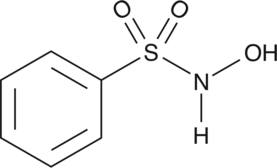Chemicals
Showing 32101–32250 of 41137 results
-
Picroside II is a flavonoid that has been isolated from P. kurroa and has diverse biological activities.{52489,52490,52491,52492} It decreases expression of FATP5 and SCD, encoding fatty acid transport protein 5 and steroyl CoA desaturase, respectively, and inhibits free fatty acid-induced lipid accumulation in HepG2 cells when used at a concentration of 10 µM.{52489} Picroside II inhibits RANKL-induced osteoclast formation in isolated murine bone marrow cells and decreases the size of bone resorption pits in bovine bone slices.{52490} In vivo, picroside II (10 and 60 mg/kg) inhibits LPS-induced trabecular bone loss in a mouse model of inflammatory osteoporosis. It prevents ischemia-reperfusion-induced testicular apoptosis and malondialdehyde (MDA) production in a rat model of testicular torsion.{52491} Picroside II also reduces airway inflammation, lung mucus hypersecretion, and bronchoalveolar lavage fluid (BALF) inflammatory cell infiltration in a mouse model of house dust mite-induced allergic asthma.{52492}
Brand:CaymanSKU:30319 - 10 mgAvailable on backorder
Picroside II is a flavonoid that has been isolated from P. kurroa and has diverse biological activities.{52489,52490,52491,52492} It decreases expression of FATP5 and SCD, encoding fatty acid transport protein 5 and steroyl CoA desaturase, respectively, and inhibits free fatty acid-induced lipid accumulation in HepG2 cells when used at a concentration of 10 µM.{52489} Picroside II inhibits RANKL-induced osteoclast formation in isolated murine bone marrow cells and decreases the size of bone resorption pits in bovine bone slices.{52490} In vivo, picroside II (10 and 60 mg/kg) inhibits LPS-induced trabecular bone loss in a mouse model of inflammatory osteoporosis. It prevents ischemia-reperfusion-induced testicular apoptosis and malondialdehyde (MDA) production in a rat model of testicular torsion.{52491} Picroside II also reduces airway inflammation, lung mucus hypersecretion, and bronchoalveolar lavage fluid (BALF) inflammatory cell infiltration in a mouse model of house dust mite-induced allergic asthma.{52492}
Brand:CaymanSKU:30319 - 100 mgAvailable on backorder
Picroside II is a flavonoid that has been isolated from P. kurroa and has diverse biological activities.{52489,52490,52491,52492} It decreases expression of FATP5 and SCD, encoding fatty acid transport protein 5 and steroyl CoA desaturase, respectively, and inhibits free fatty acid-induced lipid accumulation in HepG2 cells when used at a concentration of 10 µM.{52489} Picroside II inhibits RANKL-induced osteoclast formation in isolated murine bone marrow cells and decreases the size of bone resorption pits in bovine bone slices.{52490} In vivo, picroside II (10 and 60 mg/kg) inhibits LPS-induced trabecular bone loss in a mouse model of inflammatory osteoporosis. It prevents ischemia-reperfusion-induced testicular apoptosis and malondialdehyde (MDA) production in a rat model of testicular torsion.{52491} Picroside II also reduces airway inflammation, lung mucus hypersecretion, and bronchoalveolar lavage fluid (BALF) inflammatory cell infiltration in a mouse model of house dust mite-induced allergic asthma.{52492}
Brand:CaymanSKU:30319 - 250 mgAvailable on backorder
Picroside II is a flavonoid that has been isolated from P. kurroa and has diverse biological activities.{52489,52490,52491,52492} It decreases expression of FATP5 and SCD, encoding fatty acid transport protein 5 and steroyl CoA desaturase, respectively, and inhibits free fatty acid-induced lipid accumulation in HepG2 cells when used at a concentration of 10 µM.{52489} Picroside II inhibits RANKL-induced osteoclast formation in isolated murine bone marrow cells and decreases the size of bone resorption pits in bovine bone slices.{52490} In vivo, picroside II (10 and 60 mg/kg) inhibits LPS-induced trabecular bone loss in a mouse model of inflammatory osteoporosis. It prevents ischemia-reperfusion-induced testicular apoptosis and malondialdehyde (MDA) production in a rat model of testicular torsion.{52491} Picroside II also reduces airway inflammation, lung mucus hypersecretion, and bronchoalveolar lavage fluid (BALF) inflammatory cell infiltration in a mouse model of house dust mite-induced allergic asthma.{52492}
Brand:CaymanSKU:30319 - 50 mgAvailable on backorder
Picrotin is a natural picrotoxane that antagonizes glycine receptors (GlyRs; IC50s = 57 and 117 µM for α1 and α2 homodimeric GlyRs, respectively).{33999,42440} It also inhibits α3 homodimeric GlyRs.{34001} Picrotin is inactive in inhibiting γ-aminobutyric acid (GABA) type A and type C receptors. Picrotin occurs in the natural plant-derived poison picrotoxin (Item No. 20771), equimolar with picrotoxinin.
Brand:CaymanSKU:21870 -Out of stock
Picrotin is a natural picrotoxane that antagonizes glycine receptors (GlyRs; IC50s = 57 and 117 µM for α1 and α2 homodimeric GlyRs, respectively).{33999,42440} It also inhibits α3 homodimeric GlyRs.{34001} Picrotin is inactive in inhibiting γ-aminobutyric acid (GABA) type A and type C receptors. Picrotin occurs in the natural plant-derived poison picrotoxin (Item No. 20771), equimolar with picrotoxinin.
Brand:CaymanSKU:21870 -Out of stock
Picrotin is a natural picrotoxane that antagonizes glycine receptors (GlyRs; IC50s = 57 and 117 µM for α1 and α2 homodimeric GlyRs, respectively).{33999,42440} It also inhibits α3 homodimeric GlyRs.{34001} Picrotin is inactive in inhibiting γ-aminobutyric acid (GABA) type A and type C receptors. Picrotin occurs in the natural plant-derived poison picrotoxin (Item No. 20771), equimolar with picrotoxinin.
Brand:CaymanSKU:21870 -Out of stock
Picrotin is a natural picrotoxane that antagonizes glycine receptors (GlyRs; IC50s = 57 and 117 µM for α1 and α2 homodimeric GlyRs, respectively).{33999,42440} It also inhibits α3 homodimeric GlyRs.{34001} Picrotin is inactive in inhibiting γ-aminobutyric acid (GABA) type A and type C receptors. Picrotin occurs in the natural plant-derived poison picrotoxin (Item No. 20771), equimolar with picrotoxinin.
Brand:CaymanSKU:21870 -Out of stock
Picrotoxin is a natural plant-derived poison that acts as a selective GABAA receptor antagonist.{32532,32535} It is functional in vivo and is used to study the role of GABAA receptors in the central nervous system as well in the periphery.{32533,32534} Picrotoxin induces seizures in adult and immature animals and is used to study GABAA-dependent seizures and drugs that block this pathway.{32536}
Brand:CaymanSKU:20771 -Available on backorder
Picrotoxin is a natural plant-derived poison that acts as a selective GABAA receptor antagonist.{32532,32535} It is functional in vivo and is used to study the role of GABAA receptors in the central nervous system as well in the periphery.{32533,32534} Picrotoxin induces seizures in adult and immature animals and is used to study GABAA-dependent seizures and drugs that block this pathway.{32536}
Brand:CaymanSKU:20771 -Available on backorder
Picrotoxin is a natural plant-derived poison that acts as a selective GABAA receptor antagonist.{32532,32535} It is functional in vivo and is used to study the role of GABAA receptors in the central nervous system as well in the periphery.{32533,32534} Picrotoxin induces seizures in adult and immature animals and is used to study GABAA-dependent seizures and drugs that block this pathway.{32536}
Brand:CaymanSKU:20771 -Available on backorder
Pidotimod is a synthetic dipeptide with immunomodulatory properties on both innate and adaptive immune responses in in vitro studies.{30302} It has been shown to induce dendritic cell (DC) maturation, to upregulate the expression of HLA-DR and co-stimulatory molecules CD83 and CD86, to stimulate the release of pro-inflammatory molecules from DCs, which drives T cell proliferation and differentiation towards a Th1 phenotype, to enhance natural killer cell functions, to inhibit thymocyte apoptosis, and to promote phagocytosis.{30303} Through separate effects on ERK1/2 and NF-κB, pidotimod was shown to increase the expression of toll-like receptor 2 proteins. Pimotimod does not affect expression of ICAM-1 or the release of IL-8.{30303}
Brand:CaymanSKU:-Available on backorder
Pidotimod is a synthetic dipeptide with immunomodulatory properties on both innate and adaptive immune responses in in vitro studies.{30302} It has been shown to induce dendritic cell (DC) maturation, to upregulate the expression of HLA-DR and co-stimulatory molecules CD83 and CD86, to stimulate the release of pro-inflammatory molecules from DCs, which drives T cell proliferation and differentiation towards a Th1 phenotype, to enhance natural killer cell functions, to inhibit thymocyte apoptosis, and to promote phagocytosis.{30303} Through separate effects on ERK1/2 and NF-κB, pidotimod was shown to increase the expression of toll-like receptor 2 proteins. Pimotimod does not affect expression of ICAM-1 or the release of IL-8.{30303}
Brand:CaymanSKU:-Available on backorder
Pidotimod is a synthetic dipeptide with immunomodulatory properties on both innate and adaptive immune responses in in vitro studies.{30302} It has been shown to induce dendritic cell (DC) maturation, to upregulate the expression of HLA-DR and co-stimulatory molecules CD83 and CD86, to stimulate the release of pro-inflammatory molecules from DCs, which drives T cell proliferation and differentiation towards a Th1 phenotype, to enhance natural killer cell functions, to inhibit thymocyte apoptosis, and to promote phagocytosis.{30303} Through separate effects on ERK1/2 and NF-κB, pidotimod was shown to increase the expression of toll-like receptor 2 proteins. Pimotimod does not affect expression of ICAM-1 or the release of IL-8.{30303}
Brand:CaymanSKU:-Available on backorder
Pidotimod is a synthetic dipeptide with immunomodulatory properties on both innate and adaptive immune responses in in vitro studies.{30302} It has been shown to induce dendritic cell (DC) maturation, to upregulate the expression of HLA-DR and co-stimulatory molecules CD83 and CD86, to stimulate the release of pro-inflammatory molecules from DCs, which drives T cell proliferation and differentiation towards a Th1 phenotype, to enhance natural killer cell functions, to inhibit thymocyte apoptosis, and to promote phagocytosis.{30303} Through separate effects on ERK1/2 and NF-κB, pidotimod was shown to increase the expression of toll-like receptor 2 proteins. Pimotimod does not affect expression of ICAM-1 or the release of IL-8.{30303}
Brand:CaymanSKU:-Available on backorder
Complex I, also known as NADH:ubiquinone oxidoreductase or NADH dehydrogenase (ubiquinone), catalyzes the transfer of electrons from NADH to ubiquinone (also known as coenzyme Q10) as part of the respiratory chain leading to ATP generation. Piericidin A is an irreversible inhibitor of mitochondrial complex I that strongly associates with ubiquinone binding sites in both mitochondrial and bacterial forms of the enzyme.{24937,24940} First identified as an insecticidal metabolite produced by Streptomyces, piericidin A was soon found to bind and inhibit complex I at nanomolar concentrations.{24941,24938} The inhibition of complex I by piericidin A in the presence of NADH results in the generation of reactive oxygen species.{24936} In plants, pieridicin A inhibits photosystem II, a water-plastoquinone oxidoreductase involved in light-dependent electron transfer.{24939} Piericidin A also suppresses the up-regulation of the glucose-regulated protein GRP78 in glucose-deprived, etoposide-resistant HT-29 cells, resulting in cell death (IC50 = 7.7 nM).{24942}
Brand:CaymanSKU:-Complex I, also known as NADH:ubiquinone oxidoreductase or NADH dehydrogenase (ubiquinone), catalyzes the transfer of electrons from NADH to ubiquinone (also known as coenzyme Q10) as part of the respiratory chain leading to ATP generation. Piericidin A is an irreversible inhibitor of mitochondrial complex I that strongly associates with ubiquinone binding sites in both mitochondrial and bacterial forms of the enzyme.{24937,24940} First identified as an insecticidal metabolite produced by Streptomyces, piericidin A was soon found to bind and inhibit complex I at nanomolar concentrations.{24941,24938} The inhibition of complex I by piericidin A in the presence of NADH results in the generation of reactive oxygen species.{24936} In plants, pieridicin A inhibits photosystem II, a water-plastoquinone oxidoreductase involved in light-dependent electron transfer.{24939} Piericidin A also suppresses the up-regulation of the glucose-regulated protein GRP78 in glucose-deprived, etoposide-resistant HT-29 cells, resulting in cell death (IC50 = 7.7 nM).{24942}
Brand:CaymanSKU:-Pifithrin-α is an inactivator of p53 that blocks p53-dependent transcriptional activation and apoptosis.{17259} It prevents p53-mediated apoptosis induced by cytotoxic compounds in C8 cells at 10 μM {17259} and in human umbilical vein endothelial cells at 30 μM.{17260} Pifithrin-α can also protect cells from DNA damage-induced apoptosis by a p53-independent mechanism that might involve cyclin D1.{17261}
Brand:CaymanSKU:-Pifithrin-α is an inactivator of p53 that blocks p53-dependent transcriptional activation and apoptosis.{17259} It prevents p53-mediated apoptosis induced by cytotoxic compounds in C8 cells at 10 μM {17259} and in human umbilical vein endothelial cells at 30 μM.{17260} Pifithrin-α can also protect cells from DNA damage-induced apoptosis by a p53-independent mechanism that might involve cyclin D1.{17261}
Brand:CaymanSKU:-Pifithrin-α is an inactivator of p53 that blocks p53-dependent transcriptional activation and apoptosis.{17259} It prevents p53-mediated apoptosis induced by cytotoxic compounds in C8 cells at 10 μM {17259} and in human umbilical vein endothelial cells at 30 μM.{17260} Pifithrin-α can also protect cells from DNA damage-induced apoptosis by a p53-independent mechanism that might involve cyclin D1.{17261}
Brand:CaymanSKU:-Pifithrin-α is an inactivator of p53 that blocks p53-dependent transcriptional activation and apoptosis.{17259} It prevents p53-mediated apoptosis induced by cytotoxic compounds in C8 cells at 10 μM {17259} and in human umbilical vein endothelial cells at 30 μM.{17260} Pifithrin-α can also protect cells from DNA damage-induced apoptosis by a p53-independent mechanism that might involve cyclin D1.{17261}
Brand:CaymanSKU:-In addition to its transactivational functions, p53 mediates apoptosis by binding with the anti-apoptotic proteins Bcl-xL and Bcl-2 at the mitochondrial surface.{19632,19633} Pifithrin-μ (PFT-μ) is an inhibitor of p53-mediated apoptosis, preventing p53 binding to Bcl-xL and Bcl-2 at the mitochondria without affecting p53 transactivational activities{19632} In vitro, PFT-μ binds both p53 (Kd = 0.82 mM) and Bcl-xL (Kd = 0.80 mM).{19630} PFT-μ reduces p53-mediated apoptosis induced by γ-radiation in mouse thymocytes in vitro and protects mice from doses of radiation that cause lethal hematopoietic syndrome. At 25 μM, PFT-μ reduces apoptosis triggered by nutlin-3, which inhibits MDM2/p53 binding and potentiates p53-mediated growth arrest and apoptosis.{19633} PFT-μ also interacts selectively with heat shock protein 70 (Hsp70), leading to disruption of the association between Hsp70 and many of its co-chaperones and substrate proteins.{19631}
Brand:CaymanSKU:10748 - 10 mgAvailable on backorder
In addition to its transactivational functions, p53 mediates apoptosis by binding with the anti-apoptotic proteins Bcl-xL and Bcl-2 at the mitochondrial surface.{19632,19633} Pifithrin-μ (PFT-μ) is an inhibitor of p53-mediated apoptosis, preventing p53 binding to Bcl-xL and Bcl-2 at the mitochondria without affecting p53 transactivational activities{19632} In vitro, PFT-μ binds both p53 (Kd = 0.82 mM) and Bcl-xL (Kd = 0.80 mM).{19630} PFT-μ reduces p53-mediated apoptosis induced by γ-radiation in mouse thymocytes in vitro and protects mice from doses of radiation that cause lethal hematopoietic syndrome. At 25 μM, PFT-μ reduces apoptosis triggered by nutlin-3, which inhibits MDM2/p53 binding and potentiates p53-mediated growth arrest and apoptosis.{19633} PFT-μ also interacts selectively with heat shock protein 70 (Hsp70), leading to disruption of the association between Hsp70 and many of its co-chaperones and substrate proteins.{19631}
Brand:CaymanSKU:10748 - 25 mgAvailable on backorder
In addition to its transactivational functions, p53 mediates apoptosis by binding with the anti-apoptotic proteins Bcl-xL and Bcl-2 at the mitochondrial surface.{19632,19633} Pifithrin-μ (PFT-μ) is an inhibitor of p53-mediated apoptosis, preventing p53 binding to Bcl-xL and Bcl-2 at the mitochondria without affecting p53 transactivational activities{19632} In vitro, PFT-μ binds both p53 (Kd = 0.82 mM) and Bcl-xL (Kd = 0.80 mM).{19630} PFT-μ reduces p53-mediated apoptosis induced by γ-radiation in mouse thymocytes in vitro and protects mice from doses of radiation that cause lethal hematopoietic syndrome. At 25 μM, PFT-μ reduces apoptosis triggered by nutlin-3, which inhibits MDM2/p53 binding and potentiates p53-mediated growth arrest and apoptosis.{19633} PFT-μ also interacts selectively with heat shock protein 70 (Hsp70), leading to disruption of the association between Hsp70 and many of its co-chaperones and substrate proteins.{19631}
Brand:CaymanSKU:10748 - 5 mgAvailable on backorder
In addition to its transactivational functions, p53 mediates apoptosis by binding with the anti-apoptotic proteins Bcl-xL and Bcl-2 at the mitochondrial surface.{19632,19633} Pifithrin-μ (PFT-μ) is an inhibitor of p53-mediated apoptosis, preventing p53 binding to Bcl-xL and Bcl-2 at the mitochondria without affecting p53 transactivational activities{19632} In vitro, PFT-μ binds both p53 (Kd = 0.82 mM) and Bcl-xL (Kd = 0.80 mM).{19630} PFT-μ reduces p53-mediated apoptosis induced by γ-radiation in mouse thymocytes in vitro and protects mice from doses of radiation that cause lethal hematopoietic syndrome. At 25 μM, PFT-μ reduces apoptosis triggered by nutlin-3, which inhibits MDM2/p53 binding and potentiates p53-mediated growth arrest and apoptosis.{19633} PFT-μ also interacts selectively with heat shock protein 70 (Hsp70), leading to disruption of the association between Hsp70 and many of its co-chaperones and substrate proteins.{19631}
Brand:CaymanSKU:10748 - 50 mgAvailable on backorder
PIK-293 is a cell-permeable, selective inhibitor of the phosphatidylinositol 3-kinase (PI3K) catalytic subunit p110δ (IC50s = 100, 25, 10, and 0.24 µM for p110 subunit isoforms α, β, γ, and δ, respectively).{14312}
Brand:CaymanSKU:21283 -Out of stock
PIK-293 is a cell-permeable, selective inhibitor of the phosphatidylinositol 3-kinase (PI3K) catalytic subunit p110δ (IC50s = 100, 25, 10, and 0.24 µM for p110 subunit isoforms α, β, γ, and δ, respectively).{14312}
Brand:CaymanSKU:21283 -Out of stock
PIK-293 is a cell-permeable, selective inhibitor of the phosphatidylinositol 3-kinase (PI3K) catalytic subunit p110δ (IC50s = 100, 25, 10, and 0.24 µM for p110 subunit isoforms α, β, γ, and δ, respectively).{14312}
Brand:CaymanSKU:21283 -Out of stock
PIK-293 is a cell-permeable, selective inhibitor of the phosphatidylinositol 3-kinase (PI3K) catalytic subunit p110δ (IC50s = 100, 25, 10, and 0.24 µM for p110 subunit isoforms α, β, γ, and δ, respectively).{14312}
Brand:CaymanSKU:21283 -Out of stock
PIK-294 is a potent inhibitor of the phosphatidylinositol 3-kinase (PI3K) catalytic subunit p110δ (IC50s = 10,000, 490, 10, and 160 nM, for p110 subunit isoforms α, β, δ, and γ, respectively).{14312} It is selective for PI3K p110 subunit isoforms over DNA-PK, mTOR, and eight tyrosine kinases tested.{17883} It inhibits chemokinetic and chemotactic migration of neutrophils induced by CXCL8 in a three-dimensional collagen gel migration assay.{41154}
Brand:CaymanSKU:23427 - 1 mgAvailable on backorder
PIK-294 is a potent inhibitor of the phosphatidylinositol 3-kinase (PI3K) catalytic subunit p110δ (IC50s = 10,000, 490, 10, and 160 nM, for p110 subunit isoforms α, β, δ, and γ, respectively).{14312} It is selective for PI3K p110 subunit isoforms over DNA-PK, mTOR, and eight tyrosine kinases tested.{17883} It inhibits chemokinetic and chemotactic migration of neutrophils induced by CXCL8 in a three-dimensional collagen gel migration assay.{41154}
Brand:CaymanSKU:23427 - 10 mgAvailable on backorder
PIK-294 is a potent inhibitor of the phosphatidylinositol 3-kinase (PI3K) catalytic subunit p110δ (IC50s = 10,000, 490, 10, and 160 nM, for p110 subunit isoforms α, β, δ, and γ, respectively).{14312} It is selective for PI3K p110 subunit isoforms over DNA-PK, mTOR, and eight tyrosine kinases tested.{17883} It inhibits chemokinetic and chemotactic migration of neutrophils induced by CXCL8 in a three-dimensional collagen gel migration assay.{41154}
Brand:CaymanSKU:23427 - 25 mgAvailable on backorder
PIK-294 is a potent inhibitor of the phosphatidylinositol 3-kinase (PI3K) catalytic subunit p110δ (IC50s = 10,000, 490, 10, and 160 nM, for p110 subunit isoforms α, β, δ, and γ, respectively).{14312} It is selective for PI3K p110 subunit isoforms over DNA-PK, mTOR, and eight tyrosine kinases tested.{17883} It inhibits chemokinetic and chemotactic migration of neutrophils induced by CXCL8 in a three-dimensional collagen gel migration assay.{41154}
Brand:CaymanSKU:23427 - 5 mgAvailable on backorder
Phosphatidylinositol 3-kinase (PI3K) catalyzes the synthesis of the second messengers PtdIns-(3)-P, PtdIns-(3,4)-P2, and PtdIns-(3,4,5)-P3. The PI3K family of enzymes is comprised of 15 members that are divided into three classes according to their structure, substrate specificity, and mode of regulation.{14311} In the class I PI3Ks, p110α is the primary PI3K isoform required for insulin signaling in adipocytes and myotubes and is frequently mutated in primary tumors.{14312} Small molecule inhibitors of p110α are of interest in cancer treatment research. PIK-75 is an imidazopyridine that selectively inhibits p110α with an IC50 value of 5.8 nM.{14312} It inhibits p110γ and p110β considerably less effectively with IC50 values of 0.076 µM and 1.3 µM, respectively.{14312} In adipocytes and myotubes, PIK-75 blocks production of PIP2 and/or PIP3, phosphorylation of Akt, and activation of mTORC1.{14312}
Brand:CaymanSKU:10009210 - 1 mgAvailable on backorder
Phosphatidylinositol 3-kinase (PI3K) catalyzes the synthesis of the second messengers PtdIns-(3)-P, PtdIns-(3,4)-P2, and PtdIns-(3,4,5)-P3. The PI3K family of enzymes is comprised of 15 members that are divided into three classes according to their structure, substrate specificity, and mode of regulation.{14311} In the class I PI3Ks, p110α is the primary PI3K isoform required for insulin signaling in adipocytes and myotubes and is frequently mutated in primary tumors.{14312} Small molecule inhibitors of p110α are of interest in cancer treatment research. PIK-75 is an imidazopyridine that selectively inhibits p110α with an IC50 value of 5.8 nM.{14312} It inhibits p110γ and p110β considerably less effectively with IC50 values of 0.076 µM and 1.3 µM, respectively.{14312} In adipocytes and myotubes, PIK-75 blocks production of PIP2 and/or PIP3, phosphorylation of Akt, and activation of mTORC1.{14312}
Brand:CaymanSKU:10009210 - 10 mgAvailable on backorder
Phosphatidylinositol 3-kinase (PI3K) catalyzes the synthesis of the second messengers PtdIns-(3)-P, PtdIns-(3,4)-P2, and PtdIns-(3,4,5)-P3. The PI3K family of enzymes is comprised of 15 members that are divided into three classes according to their structure, substrate specificity, and mode of regulation.{14311} In the class I PI3Ks, p110α is the primary PI3K isoform required for insulin signaling in adipocytes and myotubes and is frequently mutated in primary tumors.{14312} Small molecule inhibitors of p110α are of interest in cancer treatment research. PIK-75 is an imidazopyridine that selectively inhibits p110α with an IC50 value of 5.8 nM.{14312} It inhibits p110γ and p110β considerably less effectively with IC50 values of 0.076 µM and 1.3 µM, respectively.{14312} In adipocytes and myotubes, PIK-75 blocks production of PIP2 and/or PIP3, phosphorylation of Akt, and activation of mTORC1.{14312}
Brand:CaymanSKU:10009210 - 25 mgAvailable on backorder
Phosphatidylinositol 3-kinase (PI3K) catalyzes the synthesis of the second messengers PtdIns-(3)-P, PtdIns-(3,4)-P2, and PtdIns-(3,4,5)-P3. The PI3K family of enzymes is comprised of 15 members that are divided into three classes according to their structure, substrate specificity, and mode of regulation.{14311} In the class I PI3Ks, p110α is the primary PI3K isoform required for insulin signaling in adipocytes and myotubes and is frequently mutated in primary tumors.{14312} Small molecule inhibitors of p110α are of interest in cancer treatment research. PIK-75 is an imidazopyridine that selectively inhibits p110α with an IC50 value of 5.8 nM.{14312} It inhibits p110γ and p110β considerably less effectively with IC50 values of 0.076 µM and 1.3 µM, respectively.{14312} In adipocytes and myotubes, PIK-75 blocks production of PIP2 and/or PIP3, phosphorylation of Akt, and activation of mTORC1.{14312}
Brand:CaymanSKU:10009210 - 5 mgAvailable on backorder
PIK-90 is a potent and cell permeable phosphoinositide 3-kinase (PI3K) inhibitor (IC50 = 11, 350, 18, and 58 nM for p110 subunit isoforms α, β, γ, and δ, respectively).{21846} Through this action, PIK-90 reduces chemotaxis and induces apoptosis in chronic lymphocytic leukemia B cells.{21846} It also blocks proliferation of glioma cells in vitro.{14311} By inhibiting P110α, PIK-90 blocks insulin-stimulated phosphorylation of Akt in L1 adipocytes and L6 myotubes, preventing activation of the mTORC1 pathway.{14312}
Brand:CaymanSKU:10010749 - 1 mgAvailable on backorder
PIK-90 is a potent and cell permeable phosphoinositide 3-kinase (PI3K) inhibitor (IC50 = 11, 350, 18, and 58 nM for p110 subunit isoforms α, β, γ, and δ, respectively).{21846} Through this action, PIK-90 reduces chemotaxis and induces apoptosis in chronic lymphocytic leukemia B cells.{21846} It also blocks proliferation of glioma cells in vitro.{14311} By inhibiting P110α, PIK-90 blocks insulin-stimulated phosphorylation of Akt in L1 adipocytes and L6 myotubes, preventing activation of the mTORC1 pathway.{14312}
Brand:CaymanSKU:10010749 - 10 mgAvailable on backorder
PIK-90 is a potent and cell permeable phosphoinositide 3-kinase (PI3K) inhibitor (IC50 = 11, 350, 18, and 58 nM for p110 subunit isoforms α, β, γ, and δ, respectively).{21846} Through this action, PIK-90 reduces chemotaxis and induces apoptosis in chronic lymphocytic leukemia B cells.{21846} It also blocks proliferation of glioma cells in vitro.{14311} By inhibiting P110α, PIK-90 blocks insulin-stimulated phosphorylation of Akt in L1 adipocytes and L6 myotubes, preventing activation of the mTORC1 pathway.{14312}
Brand:CaymanSKU:10010749 - 5 mgAvailable on backorder
PIK-93 is an inhibitor of phosphatidylinositol 4-kinase IIIβ (PI4KIIIβ; IC50 = 19 nM).{14312} It is selective for PI4KIIIβ over PI4KIIIα and PI4KIIα (IC50s = 1,100 and >100,000 nM, respectively). However, it also inhibits the PI3K catalytic subunits (IC50s = 39, 590, 120, and 16 nM for p110α, p110β, p110δ, and p110γ, respectively). PIK-93 reduces enteroviral RNA replication when used at a concentration of 125 nM in HeLa cells.{36235} It also inhibits the transport of ceramide from the endoplasmic reticulum to the Golgi apparatus.{36236}
Brand:CaymanSKU:10009212 - 1 mgAvailable on backorder
PIK-93 is an inhibitor of phosphatidylinositol 4-kinase IIIβ (PI4KIIIβ; IC50 = 19 nM).{14312} It is selective for PI4KIIIβ over PI4KIIIα and PI4KIIα (IC50s = 1,100 and >100,000 nM, respectively). However, it also inhibits the PI3K catalytic subunits (IC50s = 39, 590, 120, and 16 nM for p110α, p110β, p110δ, and p110γ, respectively). PIK-93 reduces enteroviral RNA replication when used at a concentration of 125 nM in HeLa cells.{36235} It also inhibits the transport of ceramide from the endoplasmic reticulum to the Golgi apparatus.{36236}
Brand:CaymanSKU:10009212 - 10 mgAvailable on backorder
PIK-93 is an inhibitor of phosphatidylinositol 4-kinase IIIβ (PI4KIIIβ; IC50 = 19 nM).{14312} It is selective for PI4KIIIβ over PI4KIIIα and PI4KIIα (IC50s = 1,100 and >100,000 nM, respectively). However, it also inhibits the PI3K catalytic subunits (IC50s = 39, 590, 120, and 16 nM for p110α, p110β, p110δ, and p110γ, respectively). PIK-93 reduces enteroviral RNA replication when used at a concentration of 125 nM in HeLa cells.{36235} It also inhibits the transport of ceramide from the endoplasmic reticulum to the Golgi apparatus.{36236}
Brand:CaymanSKU:10009212 - 25 mgAvailable on backorder
PIK-93 is an inhibitor of phosphatidylinositol 4-kinase IIIβ (PI4KIIIβ; IC50 = 19 nM).{14312} It is selective for PI4KIIIβ over PI4KIIIα and PI4KIIα (IC50s = 1,100 and >100,000 nM, respectively). However, it also inhibits the PI3K catalytic subunits (IC50s = 39, 590, 120, and 16 nM for p110α, p110β, p110δ, and p110γ, respectively). PIK-93 reduces enteroviral RNA replication when used at a concentration of 125 nM in HeLa cells.{36235} It also inhibits the transport of ceramide from the endoplasmic reticulum to the Golgi apparatus.{36236}
Brand:CaymanSKU:10009212 - 5 mgAvailable on backorder
PIK-III is an inhibitor of the type 3 phosphatidylinositol 3-kinase (PI3K) vacuolar protein sorting 34 (Vps34) that binds a unique hydrophobic pocket (IC50 = 18 nM).{27535} It is selective for Vps34 over related PI3K isoforms, PI4Kβ, and mTOR. PIK-III acutely inhibits autophagy and de novo lipidation of LC3, leading to stabilization of autophagy substrates.{27535}
Brand:CaymanSKU:-Out of stock
PIK-III is an inhibitor of the type 3 phosphatidylinositol 3-kinase (PI3K) vacuolar protein sorting 34 (Vps34) that binds a unique hydrophobic pocket (IC50 = 18 nM).{27535} It is selective for Vps34 over related PI3K isoforms, PI4Kβ, and mTOR. PIK-III acutely inhibits autophagy and de novo lipidation of LC3, leading to stabilization of autophagy substrates.{27535}
Brand:CaymanSKU:-Out of stock
PIK-III is an inhibitor of the type 3 phosphatidylinositol 3-kinase (PI3K) vacuolar protein sorting 34 (Vps34) that binds a unique hydrophobic pocket (IC50 = 18 nM).{27535} It is selective for Vps34 over related PI3K isoforms, PI4Kβ, and mTOR. PIK-III acutely inhibits autophagy and de novo lipidation of LC3, leading to stabilization of autophagy substrates.{27535}
Brand:CaymanSKU:-Out of stock
PIK-III is an inhibitor of the type 3 phosphatidylinositol 3-kinase (PI3K) vacuolar protein sorting 34 (Vps34) that binds a unique hydrophobic pocket (IC50 = 18 nM).{27535} It is selective for Vps34 over related PI3K isoforms, PI4Kβ, and mTOR. PIK-III acutely inhibits autophagy and de novo lipidation of LC3, leading to stabilization of autophagy substrates.{27535}
Brand:CaymanSKU:-Out of stock
Pikromycin is a macrolide antibiotic that has been found in S. venezuelae.{54353} It is active against E. coli, S. aureus, and B. subtilis (MIC99s = 50-60, 90-100, and 25-30 µM, respectively).
Brand:CaymanSKU:31331 - 2.5 mgAvailable on backorder
Pikromycin is a macrolide antibiotic that has been found in S. venezuelae.{54353} It is active against E. coli, S. aureus, and B. subtilis (MIC99s = 50-60, 90-100, and 25-30 µM, respectively).
Brand:CaymanSKU:31331 - 500 µgAvailable on backorder
Nitric Oxide (NO) is a free radical gas that is involved in a variety of biological processes including regulation vascular tone, neuronal signaling, and host defense.{5439,1650} Nitroxyl (HNO) is the one electron reduced form of nitric oxide. Piloty’s acid is one of the best known and most widely used HNO donors. Under basic conditions Piloty’s acid decomposes to HNO and benzenesulfinate anion. The rate of HNO release at pH 7 is very slow (t½ = 5,500 minutes) making its use most effective above pH 8.0. The half-life of Piloty’s acid decreases with an increase in pH to 561, 90, and 33 minutes at pH 8.0, 9.0, and 10.0, respectively.{13143} Piloty’s acid also inhibits yeast aldehyde dehydrogenase with an IC50 or 48 µM.{13144}
Brand:CaymanSKU:10006995 - 1 gAvailable on backorder
Nitric Oxide (NO) is a free radical gas that is involved in a variety of biological processes including regulation vascular tone, neuronal signaling, and host defense.{5439,1650} Nitroxyl (HNO) is the one electron reduced form of nitric oxide. Piloty’s acid is one of the best known and most widely used HNO donors. Under basic conditions Piloty’s acid decomposes to HNO and benzenesulfinate anion. The rate of HNO release at pH 7 is very slow (t½ = 5,500 minutes) making its use most effective above pH 8.0. The half-life of Piloty’s acid decreases with an increase in pH to 561, 90, and 33 minutes at pH 8.0, 9.0, and 10.0, respectively.{13143} Piloty’s acid also inhibits yeast aldehyde dehydrogenase with an IC50 or 48 µM.{13144}
Brand:CaymanSKU:10006995 - 10 gAvailable on backorder
Nitric Oxide (NO) is a free radical gas that is involved in a variety of biological processes including regulation vascular tone, neuronal signaling, and host defense.{5439,1650} Nitroxyl (HNO) is the one electron reduced form of nitric oxide. Piloty’s acid is one of the best known and most widely used HNO donors. Under basic conditions Piloty’s acid decomposes to HNO and benzenesulfinate anion. The rate of HNO release at pH 7 is very slow (t½ = 5,500 minutes) making its use most effective above pH 8.0. The half-life of Piloty’s acid decreases with an increase in pH to 561, 90, and 33 minutes at pH 8.0, 9.0, and 10.0, respectively.{13143} Piloty’s acid also inhibits yeast aldehyde dehydrogenase with an IC50 or 48 µM.{13144}
Brand:CaymanSKU:10006995 - 5 gAvailable on backorder
Nitric Oxide (NO) is a free radical gas that is involved in a variety of biological processes including regulation vascular tone, neuronal signaling, and host defense.{5439,1650} Nitroxyl (HNO) is the one electron reduced form of nitric oxide. Piloty’s acid is one of the best known and most widely used HNO donors. Under basic conditions Piloty’s acid decomposes to HNO and benzenesulfinate anion. The rate of HNO release at pH 7 is very slow (t½ = 5,500 minutes) making its use most effective above pH 8.0. The half-life of Piloty’s acid decreases with an increase in pH to 561, 90, and 33 minutes at pH 8.0, 9.0, and 10.0, respectively.{13143} Piloty’s acid also inhibits yeast aldehyde dehydrogenase with an IC50 or 48 µM.{13144}
Brand:CaymanSKU:10006995 - 500 mgAvailable on backorder
Pim-1 is a serine/threonine kinase that targets proteins involved in cell survival and proliferation and has roles in tumorigenesis.{20750,29103} Pim-1 inhibitor 2 is a potent Pim-1 inhibitor (Ki = 91 nM) that targets the ATP-binding kinase hinge region.{29105,29104,29102}
Brand:CaymanSKU:-Available on backorder
Pim-1 is a serine/threonine kinase that targets proteins involved in cell survival and proliferation and has roles in tumorigenesis.{20750,29103} Pim-1 inhibitor 2 is a potent Pim-1 inhibitor (Ki = 91 nM) that targets the ATP-binding kinase hinge region.{29105,29104,29102}
Brand:CaymanSKU:-Available on backorder
Pim-1 is a serine/threonine kinase that targets proteins involved in cell survival and proliferation and has roles in tumorigenesis.{20750,29103} Pim-1 inhibitor 2 is a potent Pim-1 inhibitor (Ki = 91 nM) that targets the ATP-binding kinase hinge region.{29105,29104,29102}
Brand:CaymanSKU:-Available on backorder
PIM447 is a pan-Pim kinase inhibitor (Kis = 6, 18, and 9 pM for Pim-1, Pim-2, and Pim-3, respectively).{52390} It is selective for Pim kinases over a panel of 383 non-mutant kinases at 1 µM. PIM447 inhibits cell growth in a panel of 26 acute myeloid leukemia (AML) cell lines (GI50s = 0.01-8.66 µM). In vivo, PIM447 (30 and 100 mg/kg) reduces tumor growth and phosphorylation of the Pim kinase target pS6RP in a KG-1 AML mouse xenograft model. It also reduces the tumor burden and prevents tumor-associated bone loss in a mouse model of bone marrow-disseminated human multiple myeloma.{52391}
Brand:CaymanSKU:29718 - 1 mgAvailable on backorder
PIM447 is a pan-Pim kinase inhibitor (Kis = 6, 18, and 9 pM for Pim-1, Pim-2, and Pim-3, respectively).{52390} It is selective for Pim kinases over a panel of 383 non-mutant kinases at 1 µM. PIM447 inhibits cell growth in a panel of 26 acute myeloid leukemia (AML) cell lines (GI50s = 0.01-8.66 µM). In vivo, PIM447 (30 and 100 mg/kg) reduces tumor growth and phosphorylation of the Pim kinase target pS6RP in a KG-1 AML mouse xenograft model. It also reduces the tumor burden and prevents tumor-associated bone loss in a mouse model of bone marrow-disseminated human multiple myeloma.{52391}
Brand:CaymanSKU:29718 - 5 mgAvailable on backorder
Pimaric acid is a resin acid that has been found in A. cordata and various pines.{43600,43601} It reduces mRNA expression, protein levels, and promoter activity of matrix metalloproteinase-9 (MMP-9) in TNF-α-stimulated human aortic smooth muscle cells (HASMCs) in a concentration-dependent manner when used at concentrations ranging from 5 to 20 μM.{43600} Pimaric acid (10-20 μM) reduces nuclear expression and binding of the transcription factors NF-κB and AP-1 to the MMP-9 promoter in HASMCs. Pimaric acid also reduces TNF-α-induced HASMC migration to control levels when used at a concentration of 20 μg/ml.
Brand:CaymanSKU:26062 - 1 mgAvailable on backorder
Pimaric acid is a resin acid that has been found in A. cordata and various pines.{43600,43601} It reduces mRNA expression, protein levels, and promoter activity of matrix metalloproteinase-9 (MMP-9) in TNF-α-stimulated human aortic smooth muscle cells (HASMCs) in a concentration-dependent manner when used at concentrations ranging from 5 to 20 μM.{43600} Pimaric acid (10-20 μM) reduces nuclear expression and binding of the transcription factors NF-κB and AP-1 to the MMP-9 promoter in HASMCs. Pimaric acid also reduces TNF-α-induced HASMC migration to control levels when used at a concentration of 20 μg/ml.
Brand:CaymanSKU:26062 - 5 mgAvailable on backorder
Pimaric acid is a resin acid that has been found in A. cordata and various pines.{43600,43601} It reduces mRNA expression, protein levels, and promoter activity of matrix metalloproteinase-9 (MMP-9) in TNF-α-stimulated human aortic smooth muscle cells (HASMCs) in a concentration-dependent manner when used at concentrations ranging from 5 to 20 μM.{43600} Pimaric acid (10-20 μM) reduces nuclear expression and binding of the transcription factors NF-κB and AP-1 to the MMP-9 promoter in HASMCs. Pimaric acid also reduces TNF-α-induced HASMC migration to control levels when used at a concentration of 20 μg/ml.
Brand:CaymanSKU:26062 - 500 µgAvailable on backorder
Pimavanserin is an inverse agonist of the serotonin (5-HT) receptor subtype 5-HT2A (IC50 = 1.86 nM; Ki = 0.5 nM).{36250} It is selective for 5-HT2A over a panel of 65 ion channels, enzymes, and receptors (Kis = >100 nM). Pimavanserin reduces head-twitch behavior and prepulse inhibition deficits induced by the 5-HT2A receptor agonist DOI (Item No. 13885) in rats at doses of 3 mg/kg, p.o. and 1-10 mg/kg, s.c., respectively. It also exhibits antipsychotic-like activity, reducing hyperactivity induced by (+)-MK-801 (Item No. 10009019) in mice. Pimavanserin acts synergistically with haloperidol (Item No. 12014) or risperidone (Item No. 13629) to suppress (+)-MK-801-induced hyperactivity and attenuates haloperidol- and risperidone-induced catalepsy in rats.{36251} Formulations containing pimavanserin have been used for the treatment of psychosis in Parkinson’s disease.{36252}
Brand:CaymanSKU:23462 - 10 mgAvailable on backorder
Pimavanserin is an inverse agonist of the serotonin (5-HT) receptor subtype 5-HT2A (IC50 = 1.86 nM; Ki = 0.5 nM).{36250} It is selective for 5-HT2A over a panel of 65 ion channels, enzymes, and receptors (Kis = >100 nM). Pimavanserin reduces head-twitch behavior and prepulse inhibition deficits induced by the 5-HT2A receptor agonist DOI (Item No. 13885) in rats at doses of 3 mg/kg, p.o. and 1-10 mg/kg, s.c., respectively. It also exhibits antipsychotic-like activity, reducing hyperactivity induced by (+)-MK-801 (Item No. 10009019) in mice. Pimavanserin acts synergistically with haloperidol (Item No. 12014) or risperidone (Item No. 13629) to suppress (+)-MK-801-induced hyperactivity and attenuates haloperidol- and risperidone-induced catalepsy in rats.{36251} Formulations containing pimavanserin have been used for the treatment of psychosis in Parkinson’s disease.{36252}
Brand:CaymanSKU:23462 - 25 mgAvailable on backorder
Pimavanserin is an inverse agonist of the serotonin (5-HT) receptor subtype 5-HT2A (IC50 = 1.86 nM; Ki = 0.5 nM).{36250} It is selective for 5-HT2A over a panel of 65 ion channels, enzymes, and receptors (Kis = >100 nM). Pimavanserin reduces head-twitch behavior and prepulse inhibition deficits induced by the 5-HT2A receptor agonist DOI (Item No. 13885) in rats at doses of 3 mg/kg, p.o. and 1-10 mg/kg, s.c., respectively. It also exhibits antipsychotic-like activity, reducing hyperactivity induced by (+)-MK-801 (Item No. 10009019) in mice. Pimavanserin acts synergistically with haloperidol (Item No. 12014) or risperidone (Item No. 13629) to suppress (+)-MK-801-induced hyperactivity and attenuates haloperidol- and risperidone-induced catalepsy in rats.{36251} Formulations containing pimavanserin have been used for the treatment of psychosis in Parkinson’s disease.{36252}
Brand:CaymanSKU:23462 - 5 mgAvailable on backorder
Pimavanserin is an inverse agonist of the serotonin (5-HT) receptor subtype 5-HT2A (IC50 = 1.86 nM; Ki = 0.5 nM).{36250} It is selective for 5-HT2A over a panel of 65 ion channels, enzymes, and receptors (Kis = >100 nM). Pimavanserin reduces head-twitch behavior and prepulse inhibition deficits induced by the 5-HT2A receptor agonist DOI (Item No. 13885) in rats at doses of 3 mg/kg, p.o. and 1-10 mg/kg, s.c., respectively. It also exhibits antipsychotic-like activity, reducing hyperactivity induced by (+)-MK-801 (Item No. 10009019) in mice. Pimavanserin acts synergistically with haloperidol (Item No. 12014) or risperidone (Item No. 13629) to suppress (+)-MK-801-induced hyperactivity and attenuates haloperidol- and risperidone-induced catalepsy in rats.{36251} Formulations containing pimavanserin have been used for the treatment of psychosis in Parkinson’s disease.{36252}
Brand:CaymanSKU:23462 - 50 mgAvailable on backorder
Pimecrolimus is a natural ascomycin macrolactam that binds to macrophilin-12 (FKBP-12) and inhibits calcineurin as well as prolyl isomerase (rotamase).{21559} Presumably through these actions, it blocks the activation of T cells by allogeneic dendritic cells (IC50 = 0.55 nM) without affecting dendritic cells.{21561,21562,21572,21573} Moreover, pimecrolimus suppresses the generation of pro-inflammatory cytokines by T cells, the release of pre-formed inflammatory mediators from mast cells, and the activation of eosinophils.{21560,21561,21557} These effects support the use of pimecrolimus in countering inflammatory skin diseases, such as atopic dermatitis (eczema) and psoriasis.{21574,21558,21571}
Brand:CaymanSKU:-Pimecrolimus is a natural ascomycin macrolactam that binds to macrophilin-12 (FKBP-12) and inhibits calcineurin as well as prolyl isomerase (rotamase).{21559} Presumably through these actions, it blocks the activation of T cells by allogeneic dendritic cells (IC50 = 0.55 nM) without affecting dendritic cells.{21561,21562,21572,21573} Moreover, pimecrolimus suppresses the generation of pro-inflammatory cytokines by T cells, the release of pre-formed inflammatory mediators from mast cells, and the activation of eosinophils.{21560,21561,21557} These effects support the use of pimecrolimus in countering inflammatory skin diseases, such as atopic dermatitis (eczema) and psoriasis.{21574,21558,21571}
Brand:CaymanSKU:-Pimecrolimus is a natural ascomycin macrolactam that binds to macrophilin-12 (FKBP-12) and inhibits calcineurin as well as prolyl isomerase (rotamase).{21559} Presumably through these actions, it blocks the activation of T cells by allogeneic dendritic cells (IC50 = 0.55 nM) without affecting dendritic cells.{21561,21562,21572,21573} Moreover, pimecrolimus suppresses the generation of pro-inflammatory cytokines by T cells, the release of pre-formed inflammatory mediators from mast cells, and the activation of eosinophils.{21560,21561,21557} These effects support the use of pimecrolimus in countering inflammatory skin diseases, such as atopic dermatitis (eczema) and psoriasis.{21574,21558,21571}
Brand:CaymanSKU:-Pimelic diphenylamide 106 is a slow, tight-binding inhibitor of class I histone deacetylases (HDACs).{16844} Unlike the HDAC inhibitor suberoylanilide hydroamic acid, which has a fast-on/fast-off HDAC binding rate, pimelic diphenylamide 106 progressively binds HDACs and remains bound after wash-out. As a result, the IC50 of pimelic diphenylamide 106 decreases over time. With prolonged preincubation (1-3 hours), pimelic diphenylamide inhibits the class I HDACs (IC50 = 150, 760, 370, and 5,000 nM for HDAC1, 2, 3, and 8, respectively) but not the class II HDACs (IC50 > 180 μM for HDAC4, 5, and 7).{16844} Pimelic diphenylamide 106 and related benzamide HDAC inhibitors may have therapeutic value in Friedrich’s ataxia{16844,17391,17392} and Huntington’s disease,{17390} in part due to their low animal toxicity.
Brand:CaymanSKU:-Pimelic diphenylamide 106 is a slow, tight-binding inhibitor of class I histone deacetylases (HDACs).{16844} Unlike the HDAC inhibitor suberoylanilide hydroamic acid, which has a fast-on/fast-off HDAC binding rate, pimelic diphenylamide 106 progressively binds HDACs and remains bound after wash-out. As a result, the IC50 of pimelic diphenylamide 106 decreases over time. With prolonged preincubation (1-3 hours), pimelic diphenylamide inhibits the class I HDACs (IC50 = 150, 760, 370, and 5,000 nM for HDAC1, 2, 3, and 8, respectively) but not the class II HDACs (IC50 > 180 μM for HDAC4, 5, and 7).{16844} Pimelic diphenylamide 106 and related benzamide HDAC inhibitors may have therapeutic value in Friedrich’s ataxia{16844,17391,17392} and Huntington’s disease,{17390} in part due to their low animal toxicity.
Brand:CaymanSKU:-Pimelic diphenylamide 106 is a slow, tight-binding inhibitor of class I histone deacetylases (HDACs).{16844} Unlike the HDAC inhibitor suberoylanilide hydroamic acid, which has a fast-on/fast-off HDAC binding rate, pimelic diphenylamide 106 progressively binds HDACs and remains bound after wash-out. As a result, the IC50 of pimelic diphenylamide 106 decreases over time. With prolonged preincubation (1-3 hours), pimelic diphenylamide inhibits the class I HDACs (IC50 = 150, 760, 370, and 5,000 nM for HDAC1, 2, 3, and 8, respectively) but not the class II HDACs (IC50 > 180 μM for HDAC4, 5, and 7).{16844} Pimelic diphenylamide 106 and related benzamide HDAC inhibitors may have therapeutic value in Friedrich’s ataxia{16844,17391,17392} and Huntington’s disease,{17390} in part due to their low animal toxicity.
Brand:CaymanSKU:-Pimelic diphenylamide 106 is a slow, tight-binding inhibitor of class I histone deacetylases (HDACs).{16844} Unlike the HDAC inhibitor suberoylanilide hydroamic acid, which has a fast-on/fast-off HDAC binding rate, pimelic diphenylamide 106 progressively binds HDACs and remains bound after wash-out. As a result, the IC50 of pimelic diphenylamide 106 decreases over time. With prolonged preincubation (1-3 hours), pimelic diphenylamide inhibits the class I HDACs (IC50 = 150, 760, 370, and 5,000 nM for HDAC1, 2, 3, and 8, respectively) but not the class II HDACs (IC50 > 180 μM for HDAC4, 5, and 7).{16844} Pimelic diphenylamide 106 and related benzamide HDAC inhibitors may have therapeutic value in Friedrich’s ataxia{16844,17391,17392} and Huntington’s disease,{17390} in part due to their low animal toxicity.
Brand:CaymanSKU:-Pimobendan is an inhibitor of phosphodiesterase 3 (PDE3; IC50 = 0.32 μM for guinea pig cardiac enzyme) that is selective for PDE3 over PDE1, PDE2, and PDE4 (IC50s = >30 μM).{46297} It is also a calcium sensitizer, decreasing the concentration of calcium required for half-maximal contractile force in isolated, skinned porcine ventricular fibers. Pimobendan increases the force of contraction in electrically-stimulated isolated guinea pig papillary muscles with an EC50 value of 6 μM, indicating positive inotropic effects.{46298} It increases survival time in dogs with congestive heart failure due to myxomatous mitral valve disease when administered in combination with angiotensin-converting enzyme inhibitors and furosemide (Item No. 17273).{46299} Formulations containing pimobendan have been used in the treatment of heart failure in dogs.
Brand:CaymanSKU:26082 - 100 mgAvailable on backorder
Pimobendan is an inhibitor of phosphodiesterase 3 (PDE3; IC50 = 0.32 μM for guinea pig cardiac enzyme) that is selective for PDE3 over PDE1, PDE2, and PDE4 (IC50s = >30 μM).{46297} It is also a calcium sensitizer, decreasing the concentration of calcium required for half-maximal contractile force in isolated, skinned porcine ventricular fibers. Pimobendan increases the force of contraction in electrically-stimulated isolated guinea pig papillary muscles with an EC50 value of 6 μM, indicating positive inotropic effects.{46298} It increases survival time in dogs with congestive heart failure due to myxomatous mitral valve disease when administered in combination with angiotensin-converting enzyme inhibitors and furosemide (Item No. 17273).{46299} Formulations containing pimobendan have been used in the treatment of heart failure in dogs.
Brand:CaymanSKU:26082 - 25 mgAvailable on backorder
Pimobendan is an inhibitor of phosphodiesterase 3 (PDE3; IC50 = 0.32 μM for guinea pig cardiac enzyme) that is selective for PDE3 over PDE1, PDE2, and PDE4 (IC50s = >30 μM).{46297} It is also a calcium sensitizer, decreasing the concentration of calcium required for half-maximal contractile force in isolated, skinned porcine ventricular fibers. Pimobendan increases the force of contraction in electrically-stimulated isolated guinea pig papillary muscles with an EC50 value of 6 μM, indicating positive inotropic effects.{46298} It increases survival time in dogs with congestive heart failure due to myxomatous mitral valve disease when administered in combination with angiotensin-converting enzyme inhibitors and furosemide (Item No. 17273).{46299} Formulations containing pimobendan have been used in the treatment of heart failure in dogs.
Brand:CaymanSKU:26082 - 50 mgAvailable on backorder
Pimodivir is an inhibitor of influenza virus polymerase basic protein 2 (PB2; KD = i = ~1.6 µM) and inhibits the activity of Axl and calcium/calmodulin-dependent protein kinase IIβ (CaMKIIβ) by greater than 50% in a panel of 65 human and rat kinases. Pimodivir decreases the replication of seven adamantine- and neuraminidase inhibitor-resistant strains of influenza virus A (EC50s = 16070), zanamivir (Item No. 15123), and favipiravir (T-705; Item No. 23384) with 50% combination index (CI50) values of 0.58, 0.64, and 0.89, respectively, in a cell-based assay.{52123} Pimodivir increases survival in a mouse model of intranasal influenza A infection when administered at doses of 1, 3, and 10 mg/kg twice per day.
Brand:CaymanSKU:29321 - 10 mgAvailable on backorder
Pimodivir is an inhibitor of influenza virus polymerase basic protein 2 (PB2; KD = i = ~1.6 µM) and inhibits the activity of Axl and calcium/calmodulin-dependent protein kinase IIβ (CaMKIIβ) by greater than 50% in a panel of 65 human and rat kinases. Pimodivir decreases the replication of seven adamantine- and neuraminidase inhibitor-resistant strains of influenza virus A (EC50s = 16070), zanamivir (Item No. 15123), and favipiravir (T-705; Item No. 23384) with 50% combination index (CI50) values of 0.58, 0.64, and 0.89, respectively, in a cell-based assay.{52123} Pimodivir increases survival in a mouse model of intranasal influenza A infection when administered at doses of 1, 3, and 10 mg/kg twice per day.
Brand:CaymanSKU:29321 - 25 mgAvailable on backorder
Pimodivir is an inhibitor of influenza virus polymerase basic protein 2 (PB2; KD = i = ~1.6 µM) and inhibits the activity of Axl and calcium/calmodulin-dependent protein kinase IIβ (CaMKIIβ) by greater than 50% in a panel of 65 human and rat kinases. Pimodivir decreases the replication of seven adamantine- and neuraminidase inhibitor-resistant strains of influenza virus A (EC50s = 16070), zanamivir (Item No. 15123), and favipiravir (T-705; Item No. 23384) with 50% combination index (CI50) values of 0.58, 0.64, and 0.89, respectively, in a cell-based assay.{52123} Pimodivir increases survival in a mouse model of intranasal influenza A infection when administered at doses of 1, 3, and 10 mg/kg twice per day.
Brand:CaymanSKU:29321 - 5 mgAvailable on backorder
Hypoxic cells are low oxygen cells that when present in tumors are radioresistant and chemoresistant. Pimonidazole is a small molecule radiosensitizer that has proven to be an effective and nontoxic hypoxia marker for human squamous cell carcinomas of the cervix, head, and neck.{15586} This immunochemical hypoxia marker has been widely used in experimental and clinical studies due to its chemical stability, water solubility, and wide tissue distribution. It is generally administered in aqueous solution by injection.
Brand:CaymanSKU:89130 - 10 mgAvailable on backorder
Hypoxic cells are low oxygen cells that when present in tumors are radioresistant and chemoresistant. Pimonidazole is a small molecule radiosensitizer that has proven to be an effective and nontoxic hypoxia marker for human squamous cell carcinomas of the cervix, head, and neck.{15586} This immunochemical hypoxia marker has been widely used in experimental and clinical studies due to its chemical stability, water solubility, and wide tissue distribution. It is generally administered in aqueous solution by injection.
Brand:CaymanSKU:89130 - 100 mgAvailable on backorder























